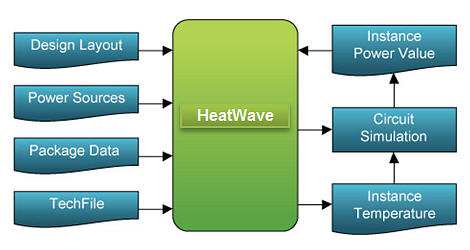What are you looking for?
HeatWave Key Features
Temperature variations on the die are caused by power dissipation within the chip. Any chip with high performance, high current and/or high voltage can have areas of high power density, causing significant temperature variations. The following video illustrates the temperature profile of a chip containing several large transistors operating in a sequence.
Temperature variations can occur in space and in time. Hotspots can move around. Heat distributes, and warms up the surrounding areas.
Mixed-signal and RF IC designers have to estimate the average temperature of the chip in order to run circuit simulation, thereby assuming uniform temperature across most or all of the die. Some designers may know that certain power transistors will create hotspots, and hence estimate a higher temperature for nearby regions. In any case, the uncertainty in these estimates is quite large. Designers need the accurate temperature for each device.
IC Thermal Simulation
Keysight’s HeatWave electro-thermal simulator eliminates the need for these estimates, instead providing accurate temperature for every device, to help reveal thermally-induced circuit failures and performance degradations before tapeout.
About HeatWave
HeatWave is an IC thermal simulator for chips, and stacked-die SiP. It computes the full-chip temperature profile at the spatial resolution of your devices and interconnect, and annotates this data into your circuit simulator, making your simulation results temperature-accurate. Because the geometric features of power sources and heat conduction paths inside a chip are at the submicron scale, the thermal modeling and numerical solution techniques have to be commensurate with such feature sizes. The simulation results are 3-dimensional temperature profiles with the necessary resolution and accuracy.

Improving Design Quality
HeatWave reveals opportunities to neutralize adverse temperature effects, by revealing hotspots and excessive temperature variations in mixed-signal designs. It provides commands to automatically monitor temperature values and variations, to help detect thermal hazards in the design.
Improving Chip Quality
HeatWave enhances your ability to detect reliability and wear-out issues, by providing nanoscale temperatures within the chip, over time.
Smooth, Painless Data Flow
HeatWave is built to fit into the standard electronic design automation (EDA) ecosystem and to make use of existing IC design data. It reads power source geometries, layout and technology file data, and package data as inputs. Its integration with the analog design flow automates device-level CAD data exchange, enabling you to simulate full-chip temperature, without laborious data preparation.
The output includes a full-chip temperature profile, provided as a graphically viewable 3-D database, and a temperature-annotated netlist for simulation. This enables your simulator to determine the impact of temperature on your circuit’s performance and reliability.

3D Visualization Capability
HeatWave can be run in interactive graphical user interface (GUI) mode, allowing the user to navigate in 3 dimensions throughout the chip and to visually inspect the temperatures on the devices, the metal layers, and other design objects.
HeatWave can also be run from a script, enabling integration of results into other analysis tools.
Automation, Capacity, Resolution
| Ansys Icepak | Mentor FloTHERM | Apache Sentinel-TI |
CapeSym SYMMIC |
Synopsys Sentaurus |
Keysight Heatwave |
|
|---|---|---|---|---|---|---|
| IC Full-Chip Capacity |
Yes | Small MMIC | Single transistor |
Yes | ||
| Device-Level Resolution |
Coarse | Coarse | Coarse | Template |
Fine | Yes Nanometer |
| Device-Level CAD Data Exchange |
Manual | Manual | RC thermal network |
Manual | Yes Layout, Power, Temperature |
|
| Analysis over Time | Yes |
Learn More
- Understand thermal hazards, including the impact on reliability and analog performance.
- Read thermal simulation research papers from IBM, ON Semi, ST, and the academic/research community.
- Read more about HeatWave, the industry's first full-chip, device-level resolution thermal simulator.
- Explore a gallery of HeatWave simulations spanning mixed signal, RF & 3DIC applications, plus demo movies.
